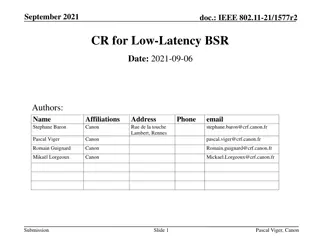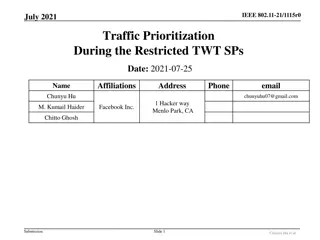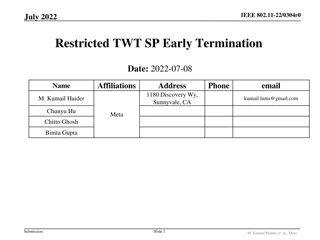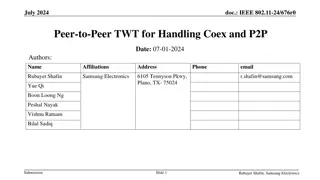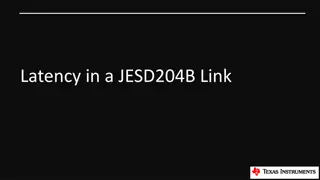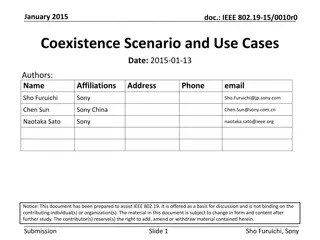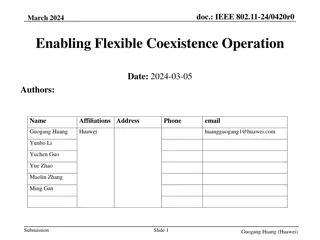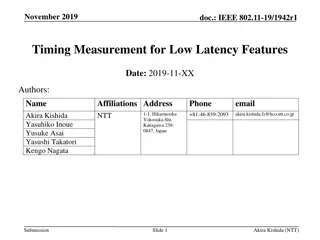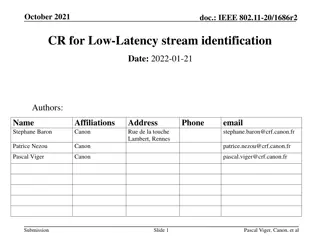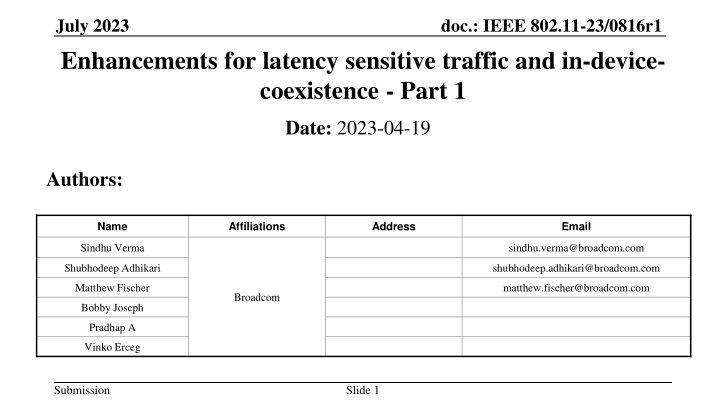
July 2023 Enhancements for Latency-Sensitive Traffic and In-Device Coexistence
"Explore protocols to enhance performance in the presence of In-Device Coexistence (IDC) constraints, addressing issues of recipient control over burst durations in scenarios involving 802.11 and BT/UWB. Proposals for semi-static adjustment of traffic parameters without re-association are discussed for improved coexistence and operational efficiency."
Download Presentation

Please find below an Image/Link to download the presentation.
The content on the website is provided AS IS for your information and personal use only. It may not be sold, licensed, or shared on other websites without obtaining consent from the author. If you encounter any issues during the download, it is possible that the publisher has removed the file from their server.
You are allowed to download the files provided on this website for personal or commercial use, subject to the condition that they are used lawfully. All files are the property of their respective owners.
The content on the website is provided AS IS for your information and personal use only. It may not be sold, licensed, or shared on other websites without obtaining consent from the author.
E N D
Presentation Transcript
July 2023 Enhancements for latency sensitive traffic and in-device- coexistence - Part 1 doc.: IEEE 802.11-23/0816r1 Date: 2023-04-19 Authors: Name Affiliations Address Email Sindhu Verma sindhu.verma@broadcom.com Shubhodeep Adhikari shubhodeep.adhikari@broadcom.com Matthew Fischer matthew.fischer@broadcom.com Broadcom Bobby Joseph Pradhap A Vinko Erceg Submission Slide 1
July 2023 doc.: IEEE 802.11-23/0816r1 Abstract This contribution discusses protocols to improve performance in the presence of In- Device-Coexistence (IDC) constraints. Submission Slide 2
July 2023 Issue: Lack of recipient s control over burst durations (1) In-device-coexistence (IDC) is significantly impacted by lack of control over long bursts of transmissions from the AP or triggered by the AP to the recipient. doc.: IEEE 802.11-23/0816r1 In IDC scenarios with 802.11 and BT/UWB, there are certain cases where continuous 802.11 medium availability is limited to a few milliseconds. A long receive packet or a burst of received packets has a high chance of crossing 802.11 medium boundaries and getting curtailed by BT So, this requires the received packet duration to be reduced in order to fit the medium availability at 802.11 (outside of BT slots or any other coexisting device). At present, coexistence between 802.11 and BT/UWB/LTE is mostly handled in a proprietary manner. Submission
July 2023 Issue: Lack of recipient s control over burst durations (2) doc.: IEEE 802.11-23/0816r1 Some non-standardized implementations may overload existing functionalities to indirectly control the time duration of the Rx/Tx packet. For DL, one can reduce AMPDU aggregation, even turn off AMPDU/AMSDU aggregation altogether or reduce the maximum length in bytes. This causes suboptimal performance without addressing the actual problem. Even upon turning off aggregation, there is no means to control the duration of a single MSDU which can be long enough to spill into the desired inactivity period. For UL, one can disable triggered mode of operation, which also disables UL OFDMA. This is again suboptimal. Coexistence between 802.11 and BT/UWB can be improved if there are standardardized mechanisms to support coexistence. The same mechanisms can be used to solve other issues of IDC such as coexistence between 802.11 and LTE/NR. They can also be used to optimize performance in case of any activity that results in temporary inability to receive/transmit 802.11 frames Submission
July 2023 doc.: IEEE 802.11-23/0816r1 Proposal 1: Semi-static Adjustment of traffic parameters without re-association (1) It is desirable to have a semi-static limit on the time duration of a burst to/from the concerned non-AP irrespective of the number of bytes or the extent of MSDU/MPDU aggregation A new action frame can be defined for semi-statically changing the DL burst duration that can be supported by the non-AP in a coex environment. Similar procedure can also be used to semi-statically adjust the duration limit for triggered UL. This will obviate the need to disable triggered UL altogether. In addition to DL/UL burst duration, it may also be beneficial to indicate the desired periodicity of DL/UL activity. For example, it can be preferred by a non-AP to have a burst duration of up to x ms in every y ms so that at least (y-x) ms is available every y ms for non-802.11 operations The supported burst parameter will be per-link/per-channel/per-band basis, as each link/channel/band can have different in-device coexistence issues (with respect to different technologies like BT/UWB/LTE/LAA/NR/NR-U). Submission Slide 5
July 2023 doc.: IEEE 802.11-23/0816r1 Proposal 2: Dynamic Adjustment of burst duration (1) The device with an IDC constraint can dynamically request to reduce the remaining burst duration Preferred remaining burst duration can be indicated through CTS or BA in response to a DL transmission. For example, CTS: The initial TXOP duration is contained in the RTS and the responder that has an IDC constraint suggests how much of remaining TXOP duration it prefers resulting in dynamic reduction of the TXOP BA: The transmission starts with a shorter DL burst and in the BA, the responder suggests the remaining TXOP duration Preferred remaining burst duration can be indicated in an UL packet transmitted in response to a trigger frame The remaining burst duration can be used either for DL transmission to this device or UL transmissions from this device that is facing an IDC constraint. It may also be beneficial to indicate the desired inactivity time after completion of the current burst. This will serve as a notice of absence. Submission Slide 6
July 2023 doc.: IEEE 802.11-23/0816r1 Proposal 2: Dynamic Adjustment of burst duration (2) Below is an illustration of dynamic adjustment of burst duration and inactivity period Here, the preferred remaining burst duration and the time until the preferred next start of 802.11 activity are indicated using a BA in response to an AMPDU In the same way, these parameters can be indicated in a CTS in response to an RTS and in a TB PPDU in response to a trigger frame Additional considerations If the remaining burst duration is reduced after the medium is reserved for a longer duration using RTS, there can be unused reserved air time left after the end of the burst to the particular non-AP. This can result in potential unfairness In that case, CF-end can be used by the AP to make this remaining duration available to other devices OR the AP can also use this remaining reserved time for other exchanges (i.e. with other non-APs) Submission Slide 7
July 2023 doc.: IEEE 802.11-23/0816r1 Straw Poll 1 Do you support the inclusion of the following in the SFD: A new action frame for semi-statically changing the Downlink/Uplink burst duration that can be supported by the non-AP in a coex environment. In addition to the burst duration, the preferred periodicity of the burst can also be indicated The supported burst parameter can be per-link/per-channel/per-band Y/N/A Submission Slide 8
July 2023 doc.: IEEE 802.11-23/0816r1 Straw Poll 2 Do you support the inclusion of the following in the SFD: Support for a mechanism or a field to dynamically indicate the remaining desired Downlink/Uplink burst duration immediately after the current transmission by the non- AP that can be supported by it in a coex environment. The field can be included in a CTS, BA or a TB PPDU In addition to the remaining burst duration, the preferred next occurence of the burst can also be indicated Y/N/A Submission Slide 9



